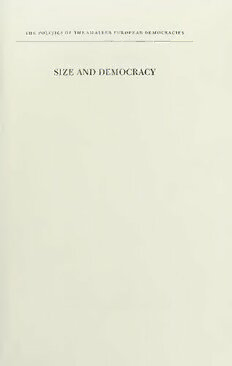
Size and Democracy PDF
Preview Size and Democracy
THE POLITICS OF THE SMALLER EUROPEAN DEMOCRACIES SIZE AND DEMOCRACY THE POLITICS OF THE SMALLER EUROPEAN DEMOCRACIES Editors Hans Daalder Val R. Lorwin Robert A. Dahl Stein Rokkan SIZE AND DEMOCRACY Robert A. Dahl arid Edward R. Tufte Stanford University Press, Stanford, California 1973 Stanford University Press Stanford, California London: Oxford University Press © 1973 by the Board of Trustees of the Leland Stanford Junior University Printed in the United States of America isbn 0-8047-0834-7 lc 72-97200 A cknowledgments We wish to thank all those, and they were numerous, who read early drafts of our manuscript and provided us with criticism and suggestions. In particular, we are indebted to our colleagues in the study of the smaller European democracies: Hans Daalder, Val Lorwin, and Stein Rokkan. As the reader will discover, the book has been greatly strengthened by data from the Swedish Communal Research Program. For their generosity in providing us with data, and their time, we wish especially to thank Jorgen Westerstahl and his colleagues. We are grateful to Nancy Hoskins for her care in typing the many revisions of the manuscript and to Joseph Verbalis, Alice- Anne Navin, and Thomas Yunck for research assistance. A stay at the Center for Advanced Study in the Behavioral Sciences in 1967 enabled us to gather and analyze data and write a first draft. We have received financial support from the Con¬ cilium on International Studies of Yale University, the Center of International Studies and the Woodrow Wilson School of Public and International Affairs at Princeton University, the Rockefeller Foundation, the Ford Foundation, and the Christian Michelsen Institute. Contents Introduction 1 1. Size and Democracy in Political Thought 4 2. Dimensions of Size and Democracy 17 3. Complexity and Diversity 30 4. Citizen Participation and Sense of Effectiveness 41 5. Citizen Communication and Control 66 6. Competition, Conflict, and Responsiveness 89 7. Size and System Capacity 110 8. Capacity for Independence and Autonomy 118 Epilogue 137 Index 145 Figures 2.1. Two criteria for the ideal democratic polity 21 2.2. Two criteria cut by indifference curves 24 5.1. Population and parliamentary size in 135 countries, 1970 82 5.2. Predicted and actual parliamentary size in 29 democra¬ cies, 1970 83 6.1. Hypothetical relation between population size and party competition 101 6.2. Population, population density, percentage of agricultural employment, and political diversity in 25 Swiss cantons, 1959-62 104 6.3. Party competition in 35 states of the United States (the South excluded), 1932-60 107 6.4. Size and the costs of dissent and participation 108 7.1. Foreign trade and population among 124 countries, 1965 114 8.1. Relation between population size and military expendi¬ tures for 113 countries 124 8.2. Relation between population size and military expendi¬ tures for 32 democracies 125 Tables g. COMPLEXITY AND DIVERSITY 3.1. Governmental centralization and size in 18 representa¬ tive democracies 38 4. CITIZEN PARTICIPATION 4.1. Interest in national elections in the United States and the Netherlands 48 4.2. Interest in political parties in the Netherlands and Finland 49 4.3. Organizational membership in five countries 49 4.4. Party membership and electoral activity in Norway and the United States 50 4.5. Political partisanship in Norway, Finland, and the United States 50 4.6. Citizens’ expectations of treatment by government officials and the police 52 4.7. Sense of political effectiveness in five countries 53 4.8. Sense of understanding the issues in five countries 54 4.9. Reported impact of governments on daily lives in five countries 56 4.10. Sense of political effectiveness at national and local levels in five countries 58 4.11. Reported attempts to influence the government in five countries 59 4.12. Correlation of political awareness with population size and density in Swedish communes 64 X Tables 5. CITIZEN COMMUNICATION AND CONTROL 5.1. Population and parliamentary size, 1970 81 5.2. Factors influencing parliamentary size in 29 democracies 83 5.3. Median family income among elected councillors and voters, Sweden, 1966 85 5.4. Positive attitude toward local taxes among Socialist and non-Socialist councillors and voters 86 6. COMPETITION, CONFLICT, AND RESPONSIVENESS 6.1. City size and organizational participation in politics, San Francisco Bay Region 98 6.2. Population size, population density, organizational participation in politics, and partisan activity in Swedish communes, 1966 99 6.3. Size, urbanization, and political diversity in the Netherlands, municipal elections of 1962 102 7. SIZE AND SYSTEM CAPACITY 7.1. Population estimates of some large medieval European cities 116 8. CAPACITY FOR INDEPENDENCE AND AUTONOMY 8.1. Simple correlation between population (log) and mili¬ tary expenditures as a per cent of GNP (log) for various groups of nations in 1964 123 8.2. Military expenditures as a per cent of GNP: multiple regression analysis 126 SIZE AND DEMOCRACY
